Assessing the Energy Performance of Solar Thermal Energy for Heat Production in Urban Areas: A Case Study
Abstract
1. Introduction
- The reduction of greenhouse emissions that are associated with the production of thermal energy.
- The reduction of noxious gases that impact a population’s health, which are associated with the production of thermal energy within urban areas.
- Framing the building that is connected or equipped with hybrid heating systems in superior classes of energy performance.
- Offering to the final consumers who are connected to the district heating system, the possibility of being directly involved, through coparticipation, in the production and management of thermal energy (based on the feed-in principle).
2. Methodology
2.1. Problem Formulation
2.2. The Purpose and Contribution of the Paper
3. Methodology
3.1. Method Description
- The efficiency of the thermal energy harness is higher than the integration of the solar fields, and it is closer to the consumption points, with the possibility of managing excess energy by delivering it to the district heating networks [40], based on the feed-in principle. In this sense, the partially decentralized integration of the solar fields at the level of the thermal points of the area have been considered.
- The available surfaces for the placement of solar collectors (i.e., on-roof terraces, roofs of parking lots, etc.).
3.2. Description of the Case Study: A Hybrid Energy System
3.2.1. Solar Energy Resources
3.2.2. The Urban Area
- for Scenario 1 (S1): G = 1.6 × 10−3 W/(m3K);
- for Scenario 2 (S2): G = 0.9 × 10−3 W/(m3K).
3.2.3. The Solar-Assisted Heating System Configuration
4. Results and Discussion
4.1. Processing the Preliminary Data Related to the Urban Area Heat Demand
4.2. Impact Indicators of the Solar-Assisted Heating System and Preliminary Data Related to the Urban Area Heat Demand
5. Conclusions
Author Contributions
Funding
Conflicts of Interest
References
- European Technology Platform on Renewable Heating and Cooling. 2020–2030–2050 Common Vision for the Renewable Heating & Cooling Sector in Europe; Publications Office of the European Union: Luxembourg, 2011; ISBN 978-92-79-19056-8. [Google Scholar]
- Bagheri, A.; Feldheim, V.; Ioakimidis, C.S. Review on the Evolution and Application of the Thermal Network Method for Energy Assessments in Buildings. Energies 2018, 11, 1–20. [Google Scholar] [CrossRef]
- European Commision CE. EU Energy in Figures, Statistical Pocketbook 2016; Publications Office of the European Union: Brussels, Belgium, 2016; ISBN 978-9-27-958248-6. [Google Scholar]
- Cohen, B. Urbanization in developing countries: Current trends, future projections, and key challenges for sustainability. Elsevier J. Technol. Soc. 2006, 28, 63–80. [Google Scholar] [CrossRef]
- DHC+ Technology Platform, Euroheat & Power. Available online: http://www.euroheat.org/DHC (accessed on 4 November 2018).
- American Society of Heating Refrigerating and Air Conditioning Engineers Inc. (ASHRAE). District/Central Solar Hot Water Systems Design Guide; ASHRAE: Atlanta, GA, USA, 2013; ISBN 978-1-936504-52-7. [Google Scholar]
- Verda, V.; Guelpa, E.; Cona, A.; Lo Russo, S. Reduction of primary energy needs in urban areas trough optimal planning of district heating and heat pump installations. Energy 2012, 48, 40–46. [Google Scholar] [CrossRef]
- Yamaguchi, Y.; Shimoda, Y. District-scale simulation for multi-purpose evaluation of urban energy systems. J. Build. Perform. Simul. 2010, 3, 289–305. [Google Scholar] [CrossRef]
- Olsthoorn, D.; Haghighat, F.; Mirzaei, P.A. Integration of storage and renewable energy into district heating systems: A review of modelling and optimization. Sol. Energy 2016, 136, 49–64. [Google Scholar] [CrossRef]
- Swan, L.G.; Ugursal, V.I. Modeling of end-use energy consumption in the residential sector: A review of modelling techniques. Renew. Sustain. Energy Rev. 2009, 13, 1819–1835. [Google Scholar] [CrossRef]
- Evins, R. A review of computational optimisation methods applied to sustainable building design. Renew. Sustain. Energy Rev. 2013, 22, 230–245. [Google Scholar] [CrossRef]
- Allegrini, J.; Orehounig, K.; Mavromatidis, G.; Ruesch, F.; Dorer, V.; Evins, R. A review of modelling approaches and tools for the simulation of district-scale energy systems. Renew. Sustain. Energy Rev. 2015, 52, 1391–1404. [Google Scholar] [CrossRef]
- Așchilean, I.; Giurca, I. Choosing a Water Distribution Pipe Rehabilitation Solution using the Analytical Network Process Method. Water 2018, 10, 484. [Google Scholar] [CrossRef]
- Kecebaş, A.; Yabanova, I. Thermal monitoring and optimization of a geothermal district heating systems using artificial neural network. Study Case. J. Energy Build. 2012, 50, 339–346. [Google Scholar] [CrossRef]
- Yabanova, I.; Kecebaş, A. Development of ANN model for geothermal district heating system and novel PID-based control strategy. J. Appl. Therm. Eng. 2013, 51, 908–916. [Google Scholar] [CrossRef]
- Wojdyga, K. Predicting Heat Demand for a District Heating Systems. Int. J. Energy Power Eng. 2014, 3, 237–244. [Google Scholar] [CrossRef]
- De Rosa, M.; Bianco, V.; Scarpa, F.; Tagliafico, L.A. Heating and Cooling building energy demand evaluation; A simplified model and a modified degree days approach. Appl. Energy 2014, 128, 217–229. [Google Scholar] [CrossRef]
- Morille, B.; Musy, M.; Malys, L. Preliminary study of the impact of urban greenery types on energy consumption of building at a district scale: Academic study on a canyon street in Nantes (France) weather conditions. Energy Build. 2016, 114, 275–282. [Google Scholar] [CrossRef]
- Agrell, P.J.; Bogetoft, P. Economic and environmental efficiency of district heating plants. Energy Policy 2005, 33, 1351–1362. [Google Scholar] [CrossRef]
- Chen, X.; Wang, L.; Tong, L.; Sun, S.; Yue, X.; Yin, S.; Zheng, L. Energy saving and emission reduction of china urban district heating. Energy Policy 2013, 55, 677–682. [Google Scholar] [CrossRef]
- Lake, A.; Rezaie, B.; Beyerlein, S. Review of district heating and cooling systems for a sustainable future. Renew. Sustain. Energy. Rev. 2017, 67, 417–425. [Google Scholar] [CrossRef]
- Parra, D.; Norman, S.A.; Walker, G.S.; Gillott, M. Optimum community energy storage for renewable energy and demand load management. AP Energy 2017, 200, 358–369. [Google Scholar] [CrossRef]
- Tung Ha, T.; Zhang, Y.; Hao, J.; Thang, V.V.; Li, C.; Cai, Z. Energy Hub’s Structural and Operational Optimization for Minimal Energy Usage Costs in Energy Systems. Energies 2018, 11, 707. [Google Scholar] [CrossRef]
- Moraitis, P.; Kausika, B.B.; Nortier, N.; van Sark, W. Urban Environment and Solar PV Performance: The Case of the Netherlands. Energies 2018, 11, 1333. [Google Scholar] [CrossRef]
- Dalla Rosa, A.; Li, H.; Svendsen, S.; Werner, S.; Persson, U.; Rühling, K.; Felsmann, C.; Crane, M.; Burzynski, R.; Bevilacqua, C. Annex X Final Report: Toward 4th Generation District Heating; Technical Report IEA DHC/CHP; DTU Library: Kongens Lyngby, Denmark, 2014. [Google Scholar]
- Genon, G.; Torchio, M.F.; Poggio, A.; Poggio, M. Energy and environmetal assessment of small district heating systems: Global and local effects in two case-studies. Energy Conv. Manag. 2009, 50, 522–529. [Google Scholar] [CrossRef]
- Torchio, M.; Genon, G.; Poggio, A.; Poggio, M. Merging of energy and environmental analyses for district heating systems. Energy 2009, 34, 220–227. [Google Scholar] [CrossRef]
- Cannistraro, G.; Cannistraro, M.; Cannistraro, A.; Galvagno, A. Analysis of Air Pollution in the Urban Center Cities Sicilian. Int. J. Heat Technol. 2016, 34, 219–225. [Google Scholar] [CrossRef]
- Schmidt, T.; Mangold, D.; Muller-Steinhagen, H. Seasonal thermal energy storage in Germany. In Proceedings of the Solites, ISES Solar World Congress 2003, Goteborg, Schweden, 14–19 June 2003. [Google Scholar]
- Schmidt, T.; Mangold, D. The multi-functional heat storage in Hamburg-Bramfeld—Innovative extension of the oldest German solar energy housing estate. In Proceedings of the Solites, IRES 2010, Berlin, Germany, 22–24 November 2010. [Google Scholar]
- SDH Solar District Heating. Available online: http://www.solar-district-heating.eu (accessed on 4 November 2018).
- Heymann, M.; Kretzschmar, T.; Rosemann, T.; Ruhling, K. Integration of Solar Thermal Systems intoDistrict Heating. In Proceedings of the 2nd International Solar District Heating Conference, Hamburg, Germany, 3–4 June 2014. [Google Scholar]
- Heymann, M.; Ruhling, K. Integration of Solar Thermal Systems into District Heating—Results of a Case Study Done in the R&D Project ‘‘DECENTRAL’’. In Proceedings of the 3nd International Solar District Heating Conference, Toulouse, France, 17–18 June 2015. [Google Scholar]
- Schafer, K.; Mangold, D. Integration of Solar Thermal Systems into District Heating—Results of a Case Study Done in the R&D Project ‘‘DECENTRAL’’. In Proceedings of the 3nd International Solar District Heating Conference. Solites, Toulouse, France, 17–18 June 2015. [Google Scholar]
- Renewable Energy in District Heating and Cooling. Available online: www.irena.org/publications (accessed on 4 November 2018).
- Heymann, M.; Ruhling, K.; Felsmann, C. Integration of Solar Thermal Systems into District Heating—DH System Simulation. Energy Procedia 2017, 116, 394–402. [Google Scholar] [CrossRef]
- Coskun, C.; Oktay, Z.; Dincer, I. New energy and exergy parameters for geothermal district heating systems. Appl. Therm. Eng. 2009, 29, 2235–2242. [Google Scholar] [CrossRef]
- INCERC Bucharest. Romanian Normative NP 048-2000, Normative for the Thermal and Energy Expertise of Existing Buildings and Their Heating and Domestic Hot Water Installations; Constructions Bulletin: Bucharest, Romania, 2001. [Google Scholar]
- Institute of Design, Research and Computing in Construction IPCT-SA. Framework Solutions for the Thermo-Hygro-Energy Rehabilitation of the Envelope of the Existing Buildings SC 007-02; FAST PRINT: Bucharest, Romania, 2005. [Google Scholar]
- Șoimoșan, T.M.; Felseghi, R.A. Comparative thermo-energetic analysis of the district heating systems that harness renewable energy sources. Sci. Procedia Eng. 2017, 181, 754–761. [Google Scholar] [CrossRef]
- Surface Meteorology and Solar Energy. Available online: https://eosweb.larc.nasa.gov (accessed on 6 August 2015).
- Şoimoșan, T.-M. Contributions Regarding the Optimization of the Heating Systems in Urban Localities. Ph.D. Thesis, Technical University of Cluj-Napoca, Cluj-Napoca, Romania, 2015. [Google Scholar]
- Romanian Standard. SR 1907-1/2014, Heating Installations. Heating Demand Calculation; Romanian Institute of Standardization; ASRO: Bucharest, Romania, 2014. [Google Scholar]
- Romanian Standard. SR 4839-1997, Heating Installations. Annual Number of Days-Degrees; Romanian Institute of Standardization; ASRO: Bucharest, Romania, 2014. [Google Scholar]
- Romanian Normative. C 107-2005, Regarding Thermo-Technical Calculation of the Building Elements; FAST PRINT: Bucharest, Romania, 2006. [Google Scholar]
- Pop, L. (TERMOFICARE ORADEA SA, Oradea, Romania). Personal communication, 2014.
- Winwatt-Ro XXL, version 2005, Termotechnical Software for Buildings; PROMAX ENGINEERING SRL: Miercurea Ciuc, Romania, 2017.
- University of Civil Engineering Bucharest; INCERC Bucharest & al. Mc 001/1-2006, Methodology for 6calculating the Energy Performance of Buildings, Part I; ASRO: Bucharest, Romania, 2006. [Google Scholar]
- Algorithm+ SRL & IPCT Installations, version 7.2, Termotechnical Software for Buildings; ALGORITHM+ SRL: Galati, Romania, 2017.
- Șoimoșan, T.M.; Felseghi, R.A. Efficient Solar Technique for Buildings Connected to the District Heating System. Indicators of Performance. In Book 4 Energy and Clean Technology, Vol. III Recycling. Air Pollution & Climate Change. Modern Energy and Power Sources; Elsevier Ltd.: Amsterdam, The Netherlands, 2016. [Google Scholar]
- Polysun Designer, version 2016; Vela Solaris AG: Winterthur, Switzerland, 2016.
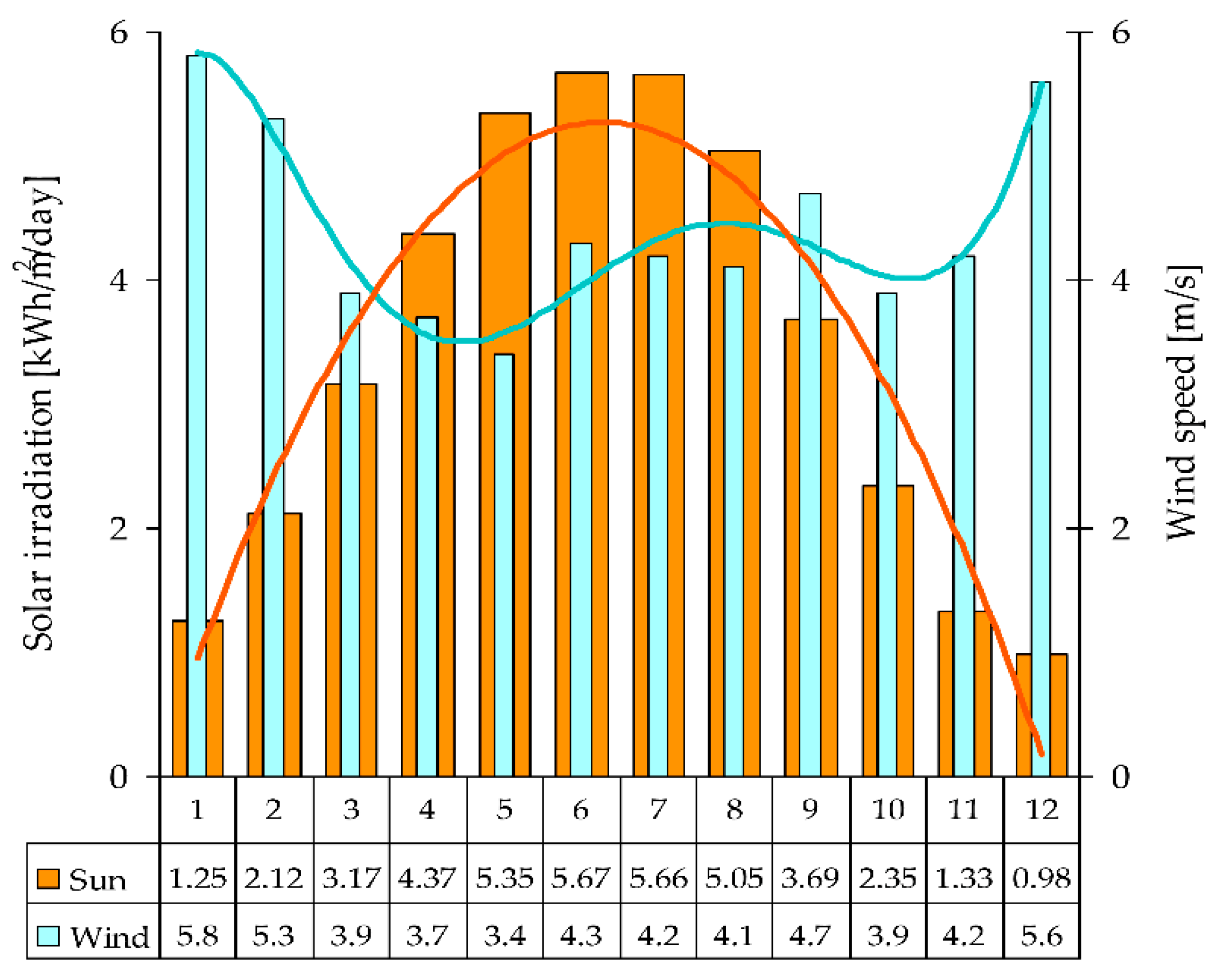

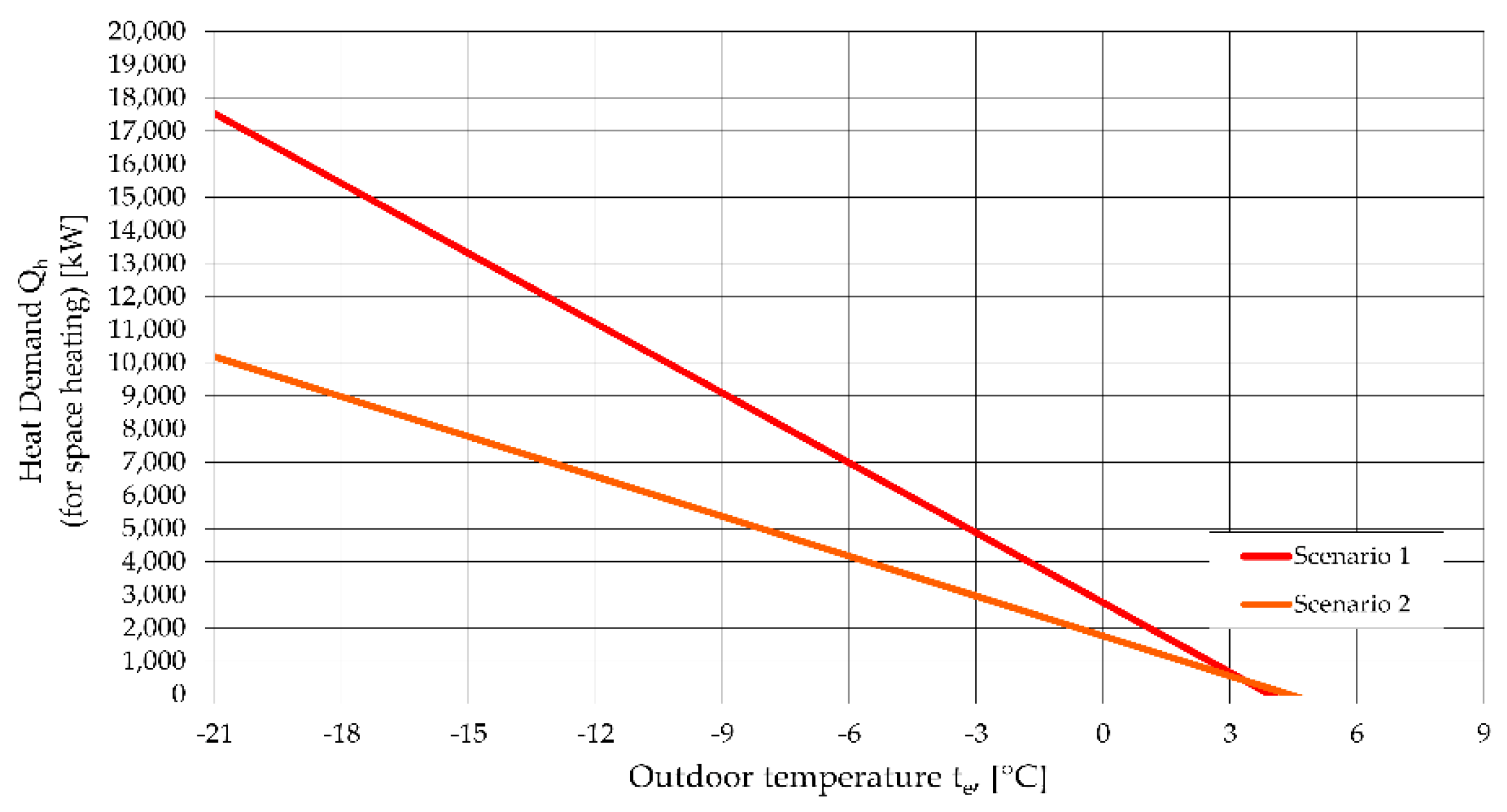

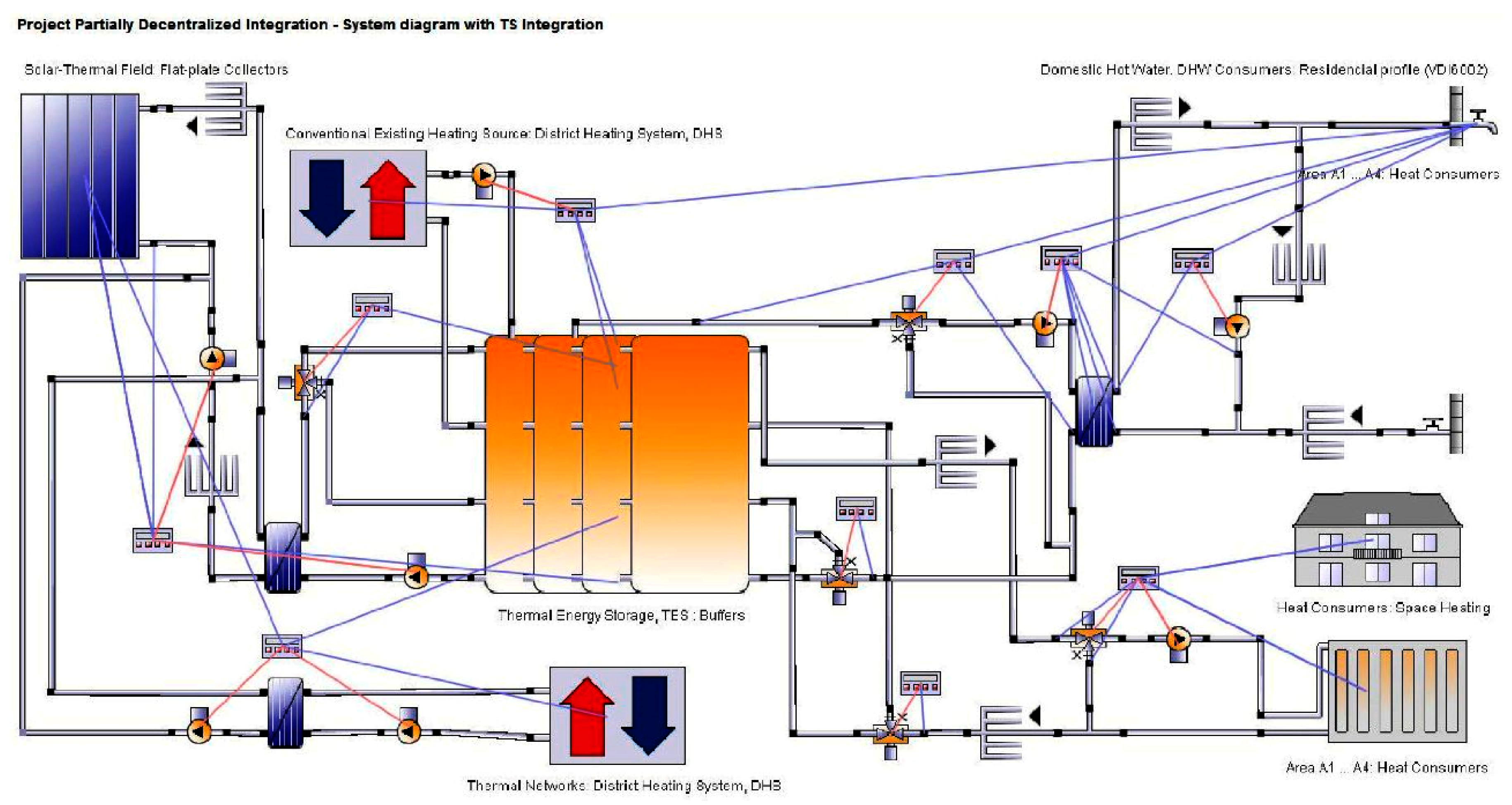

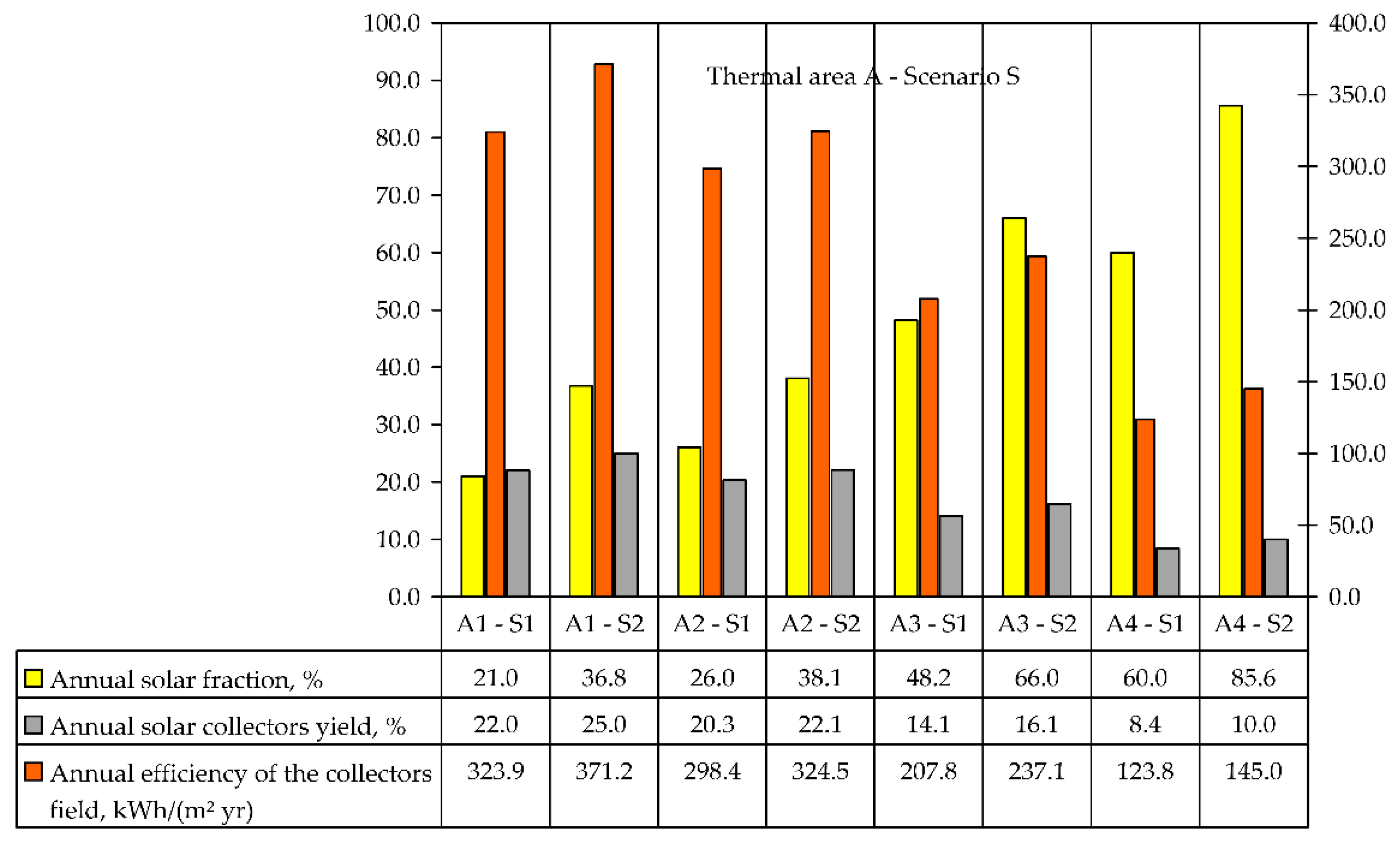
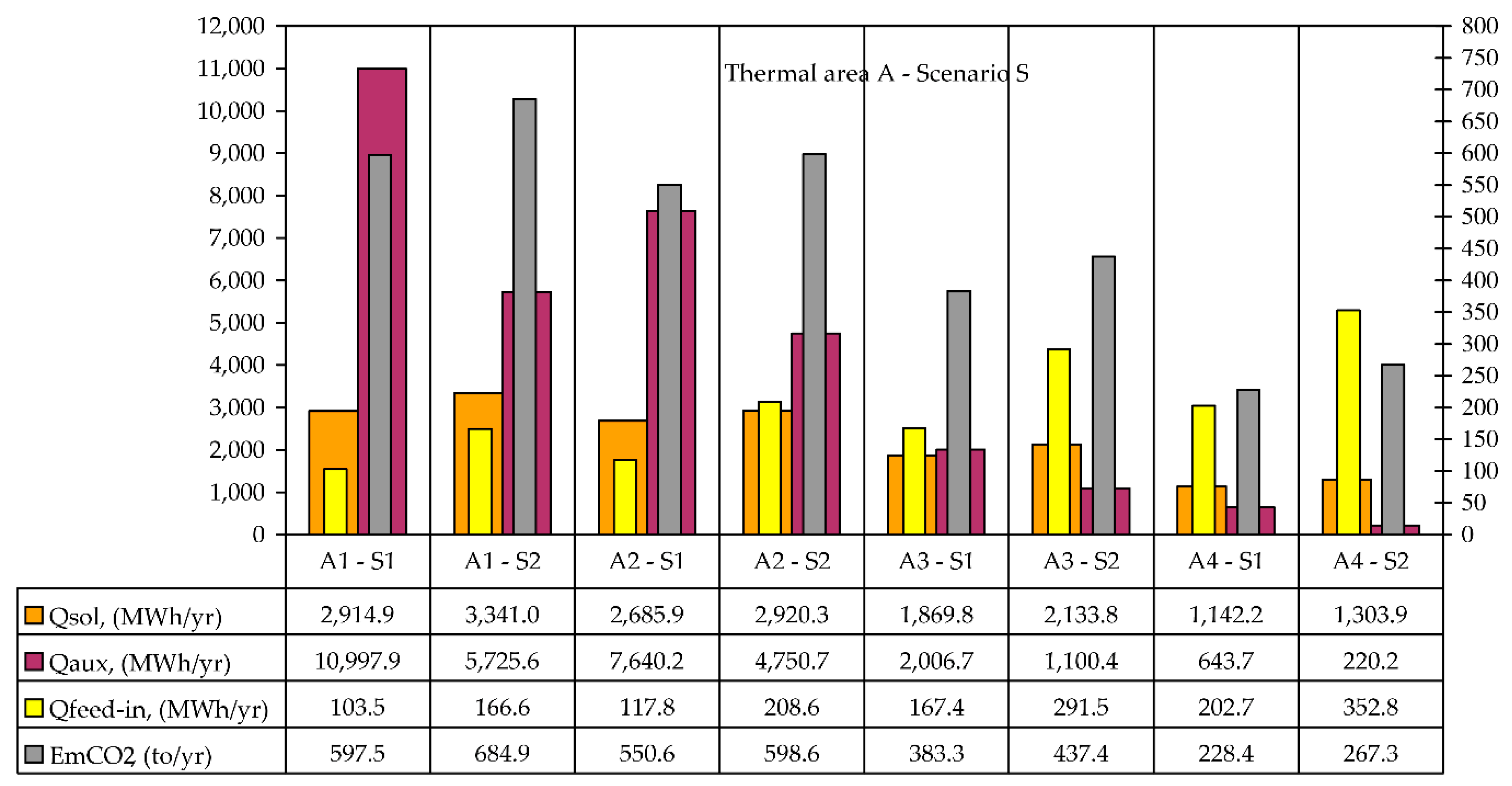

| Climate Characteristics | Value | Unit |
|---|---|---|
| Climate Area (of winter) [43,44,45] | II | |
| Outdoor temperature calculation on a stationary regime | −15 | °C |
| Ground temperature calculation | +10 | °C |
| Calculation of degrees-days at an outdoor temperature of +12 °C | 3150 | degrees-days |
| Calculation of degrees-days at an outdoor temperature of +10 °C | 2990 | degrees-days |
| Conventional duration of the heating period at an outdoor temperature of +12 °C | 195 | days |
| Conventional duration of the heating period at an outdoor temperature of +10 °C | 175 | days |
| Wind Area [43] | IV | |
| Calculation of outdoor velocity | 4 | m/s |
| Sun Exposure Area According to the National Institute of Meteorology and Hydrology (INMH) | II | |
| Annual average of solar radiation | 1150–1250 | kWh/m2 |
| Annual sunshine period | 2000–2100 | h/year |
| Area | Thermal Density | Territorial Surface of Reference | Built Volume | No. of Consumers of DHW |
|---|---|---|---|---|
| - | - | m2 | m3 | pers. |
| A1 | very high | 32,000 | 185,390 | 2755 |
| A2ref | high | 32,000 | 176,950 | 2600 |
| A3 | medium | 32,000 | 52,521 | 1048 |
| A4 | low | 32,000 | 23,530 | 277 |
| Thermo-Energy Performance Class | A | B | C | D | E | F | G |
|---|---|---|---|---|---|---|---|
| - | kWh/(m2year) | ||||||
| Heating | ≤70 | ≤117 | ≤173 | ≤245 | ≤343 | ≤500 | ˃500 |
| Domestic hot water (DHW) | 15 | 35 | 59 | 90 | 132 | 200 | 200 |
| Initial Thermo-Energy Performance (before Thermal Retrofit of Building) | ||||||||
|---|---|---|---|---|---|---|---|---|
| Area | Hourly Heat Demand | Thermal Density of the Area | Annual Demand of Energyt | Specific Annual Demand of Energyt * | Thermo-Energy Classification | |||
| for Space Heating | for DHW | Total | Heating | Integrated | ||||
| - | MW | MW | MW | W/m2 | MWh/year | kWh/(m2year) | - | |
| A1 | 6.711 | 0.868 | 7.579 | 236.84 | 15,441.60 | 304.28 | C | D |
| A2ref | 4.787 | 0.703 | 5.490 | 171.56 | 12,602.17 | 241.76 | B | D |
| A3 | 1.250 | 0.150 | 1.400 | 43.75 | 3575.38 | 297.95 | D | D |
| A4 | 0.560 | 0.110 | 0.670 | 20.94 | 1363.00 | 214.31 | C | C |
| A1–A4 | 13.308 | 1.831 | 15.139 | 118.27 | 32,982.15 | 273.46 | C | D |
| Final Thermo-Energy Performance (after Thermal Retrofit of Building) | ||||||||
|---|---|---|---|---|---|---|---|---|
| Area | Hourly Heat Demand | Thermal Density of the Area | Annual Demand of Energyt | Specific Annual Demand of Energyt * | Thermo-Energy Classification | |||
| for Space Heating | for DHW | Total | Heating | Integrated | ||||
| - | MW | MW | MW | W/m2 | MWh/year | kWh/(m2 year) | - | |
| A1 | 3.578 | 0.868 | 4.446 | 138.94 | 9686.00 | 191.80 | A | C |
| A2ref | 3.038 | 0.703 | 3.741 | 116.91 | 8781.98 | 168.47 | A | C |
| A3 | 0.800 | 0.150 | 0.950 | 29.69 | 2819.75 | 235.98 | B | D |
| A4 | 0.360 | 0.110 | 0.470 | 12.81 | 1027.78 | 161.60 | B | C |
| A1–A4 | 7.776 | 1.831 | 9.607 | 75.05 | 22,315.51 | 186.06 | B | C |
| Area | Annual Demand of Energyt (for Space Heating) | Optimized Annual Demand of Energyt (for Space Heating) |
|---|---|---|
| Scenario S1 | Scenario S2 | |
| - | MWh/year | MWh/year |
| A1 | 15,441.60 | 9686.00 |
| A2 | 12,602.17 | 8781.98 |
| A3 | 3575.38 | 2819.75 |
| A4 | 1363.00 | 1027.78 |
| Total A1—A4 | 32,982.15 | 22,315.51 |
| Automation | Automation Input (Sensors) | Automation Output (Actuators) | |||||
|---|---|---|---|---|---|---|---|
| - | Value | Unit | - | Value | Unit | ||
| Solar loop pump | Variable flow | Collector temperature | Temperature output | °C | On/Off pump | Solar loop pump: On/Off | % |
| Thermal storage tank temperature | Inferior level | °C | On/Off pump | Solar loop pump: On/Off | % | ||
| Temperature collector input | Temperature input | °C | Pumping capacity | Solar loop pump: Volumetric flow | L/h | ||
| Collectors efficiency | Collectors | kWh | Pumping capacity | Solar loop pump: Volumetric flow | L/h | ||
| Auxiliary heating system | Temperature sensor switches on | Thermal energy storage (TES): Layer 11 | °C | On/Off auxiliary heating | Auxiliary heating: On/Off | % | |
| Temperature sensor switches off | TES: Layer 9 | °C | On/Off pump | Auxiliary heating pump: On/Off | % | ||
| Volumetric flow | Designed volumetric flow | L/h | Volumetric flow control | Auxiliary heating pump: Volumetric flow | L/h | ||
| Thermal storage tank | Temperature sensor | Solar loop: TES temperature input | °C | On/Off switch | 3-way electrovalve solar loop: deviation circuit | - | |
| Temperature sensor | TES: Layer 10 | °C | |||||
| District heating network | Temperature sensor | TES: Layer 3 | °C | On/Off switch | Pump: On/Off | % | |
| Temperature sensor | Temperature collector output | °C | On/Off switch | Discharge pump: On/Off | % | ||
| Temperature sensor | Temperature collector output | °C | On/Off switch | Discharge pump: On/Off | % | ||
| Temperature sensor | Discharge: Return temperature setting | °C | - | - | - | ||
| Indicators of Thermo-Energy Balance A1 | Unit | Value | |||||
| - | - | Scenario 1 | Scenario 2 | ||||
| Annual demand of energyt (in buildings) | MWh/year | 15,441.60 | 9686.00 | ||||
| Annual solar fraction | αy | % | 21.0 | 36.8 | |||
| Solar collector field | Total area | S | m2 | 10.000 | |||
| Aperture area | A | m2 | 9.000 | ||||
| Annual global yield of the solar collector | ηc | % | 22.0 | 25.3 | |||
| Annual efficiency of the solar collector field | kWh/(m2 year) | 323.9 | 371.2 | ||||
| Exergetic components of the thermo-energy balance | Qsol | MWh/year | 2914.9 | 3341.0 | |||
| Qfeed-in | MWh/year | 103.5 | 166.6 | ||||
| Qaux | MWh/year | 10,997.9 | 5725.6 | ||||
| Indicators of thermo-energy balance A2 | Unit | Value | |||||
| - | - | Scenario 1 | Scenario 2 | ||||
| Annual demand of energyt (in buildings) | MWh/year | 12,602.17 | 8781.98 | ||||
| Annual solar fraction | αy | % | 26.0 | 38.1 | |||
| Solar collector field | Total area | S | m2 | 10,000 | |||
| Aperture area | A | m2 | 9000 | ||||
| Annual global yield of the solar collector | ηc | % | 20.3 | 22.1 | |||
| Annual efficiency of the solar collector field | kWh/(m2 year) | 298.4 | 324.5 | ||||
| Exergetic components of the thermo-energy balance | Qsol | MWh/year | 2685.9 | 2920.3 | |||
| Qfeed-in | MWh/year | 117.8 | 208.6 | ||||
| Qaux | MWh/year | 7640.2 | 4750.7 | ||||
| Indicators of the thermo-energy balance A3 | Unit | Value | |||||
| - | - | Scenario 1 | Scenario 2 | ||||
| Annual demand of energyt (in buildings) | MWh/year | 3575.38 | 2819.75 | ||||
| Annual solar fraction | αa | % | 48.2 | 66.0 | |||
| Solar collector field | Total area | S | m2 | 10,000 | |||
| Aperture area | A | m2 | 9000 | ||||
| Annual global yield of the solar collector | ηc | % | 14.1 | 16.1 | |||
| Annual efficiency of the solar collector field | kWh/(m2 year) | 207.8 | 237.1 | ||||
| Exergetic components of the thermo-energy balance | Qsol | MWh/year | 1869.8 | 2133.8 | |||
| Qfeed-in | MWh/year | 167.4 | 291.5 | ||||
| Qaux | MWh/year | 2006.7 | 1100.4 | ||||
| Indicators of thermo-energy balance A4 | Unit | Value | |||||
| - | - | Scenario 1 | Scenario 2 | ||||
| Annual demand of energyt (in buildings) | MWh/year | 1363.00 | 1027.78 | ||||
| Annual solar fraction | αa | % | Reference ~60.0 | 85.6 | |||
| Solar collector field | Total area | S | m2 | 10,000 | |||
| Aperture area | A | m2 | 9000 | ||||
| Annual global yield of the solar collector | ηc | % | 8.4 | 10.0 | |||
| Annual efficiency of the solar collector field | kWh/(m2 year) | 123.8 | 145.0 | ||||
| Exergetic components of the thermo-energy balance | Qsol | MWh/year | 1114.2 | 1303.9 | |||
| Qfeed-in | MWh/year | 202.7 | 352.8 | ||||
| Qaux | MWh/year | 643.7 | 220.2 | ||||
| Area | Scen. | Solar Thermal Energy, Annually Delivered into the System | Thermal Energy Annually Delivered into the System by an Auxiliary Conventional Heating Source | Solar Thermal Energy Annually Delivered into the District Heating Network | Maximum Quantity of CO2 Emissions Annually Avoided (ref. Natural Gases) |
|---|---|---|---|---|---|
| - | - | Qsol | Qaux | Qfeed-in | EmCO2 |
| - | - | MWh/year | MWh/year | MWh/year | kg CO2/year |
| A1 | S1 | 2914.9 | 10,997.9 | 103.5 | 597,554.5 |
| S2 | 3341.0 | 5725.6 | 166.6 | 684,905.0 | |
| A2 | S1 | 2685.9 | 7640.2 | 117.8 | 550,609.5 |
| S2 | 2920.3 | 4750.7 | 208.6 | 598,661.5 | |
| A3 | S1 | 1869.8 | 2006.7 | 167.4 | 383,309.0 |
| S2 | 2133.8 | 1100.4 | 291.5 | 437,429.0 | |
| A4 | S1 | 1114.2 | 643.7 | 202.7 | 228,411.0 |
| S2 | 1303.9 | 220.2 | 352.8 | 267,299.5 |
| Indicators of Thermo-Energy Performance | Unit | Area | ||||||||
|---|---|---|---|---|---|---|---|---|---|---|
| A1 | A2 | A3 | A4 | |||||||
| Scenario | ||||||||||
| S1 | S2 | S1 | S2 | S1 | S2 | S1 | S2 | |||
| Specific annual heat demand, Qsa | kWh/(m2 year) | 304.3 | 190.9 | 241.8 | 168.5 | 317.8 | 250.6 | 214.3 | 161.6 | |
| Conventional primary energy indicator Econv | kWh/(m2 year) | 216.7 | 112.8 | 146.6 | 91.1 | 178.4 | 97.8 | 101.2 | 34.6 | |
| Emissions equivalent indicator * EmCO2 | kgCO2/(m2 year) | 11.8 | 13.5 | 10.6 | 11.5 | 34.1 | 38.9 | 35.9 | 42.0 | |
| Indicator of primary energy from renewable energy sources (at the thermal station TS) Eres-TS | kWh/(m2 year) | 57.4 | 65.8 | 51.5 | 56.0 | 166.2 | 189.7 | 175.2 | 205.0 | |
| Indicator of primary energy from renewable energy sources (at the consumers) Eres-C | kWh/(m2 year) | 55.4 | 62.6 | 49.3 | 52.0 | 151.3 | 163.8 | 143.3 | 149.5 | |
| Area | No. of Consumers | Specific Indicators Achieved | |||||
| - | - | Scenario 1 | Scenario 2 | ||||
| qaux | qsol | qfeed-in | qaux | qsol | qfeed-in | ||
| - | pers. | kWh/(year·pers.) | kWh/(year·pers.) | ||||
| A1 | 2755 | 3992.0 | 1058.0 | 37.6 | 2078.3 | 1212.7 | 60.5 |
| A2 | 2600 | 2938.5 | 1033.0 | 45.3 | 1827.2 | 1123.2 | 80.2 |
| A3 | 1048 | 1914.8 | 1784.2 | 159.7 | 1050.0 | 2036.1 | 278.1 |
| A4 | 277 | 2323.8 | 4022.4 | 202.7 | 794.9 | 4707.2 | 1273.6 |
| Area | No. of Consumers | Maximum specific quantities of CO2 emissions *,annually avoided | |||||
| - | pers. | kg/(year·pers.) | |||||
| A1 | 2755 | 216.9 | 248.6 | ||||
| A2 | 2600 | 211.8 | 230.3 | ||||
| A3 | 1048 | 365.8 | 417.4 | ||||
| A4 | 277 | 824.6 | 965.0 | ||||
© 2019 by the authors. Licensee MDPI, Basel, Switzerland. This article is an open access article distributed under the terms and conditions of the Creative Commons Attribution (CC BY) license (http://creativecommons.org/licenses/by/4.0/).
Share and Cite
Șoimoșan, T.M.; Moga, L.M.; Danku, G.; Căzilă, A.; Manea, D.L. Assessing the Energy Performance of Solar Thermal Energy for Heat Production in Urban Areas: A Case Study. Energies 2019, 12, 1088. https://doi.org/10.3390/en12061088
Șoimoșan TM, Moga LM, Danku G, Căzilă A, Manea DL. Assessing the Energy Performance of Solar Thermal Energy for Heat Production in Urban Areas: A Case Study. Energies. 2019; 12(6):1088. https://doi.org/10.3390/en12061088
Chicago/Turabian StyleȘoimoșan, Teodora Melania, Ligia Mihaela Moga, Gelu Danku, Aurica Căzilă, and Daniela Lucia Manea. 2019. "Assessing the Energy Performance of Solar Thermal Energy for Heat Production in Urban Areas: A Case Study" Energies 12, no. 6: 1088. https://doi.org/10.3390/en12061088
APA StyleȘoimoșan, T. M., Moga, L. M., Danku, G., Căzilă, A., & Manea, D. L. (2019). Assessing the Energy Performance of Solar Thermal Energy for Heat Production in Urban Areas: A Case Study. Energies, 12(6), 1088. https://doi.org/10.3390/en12061088








